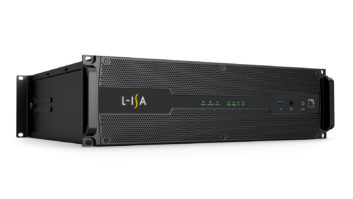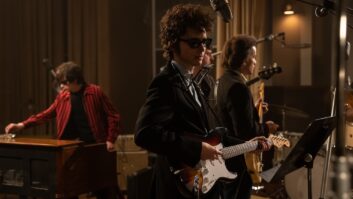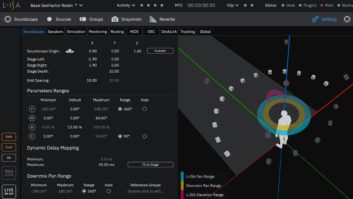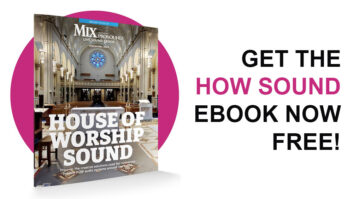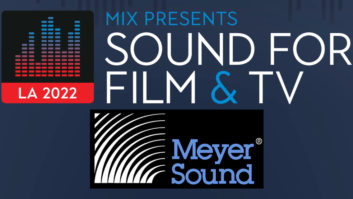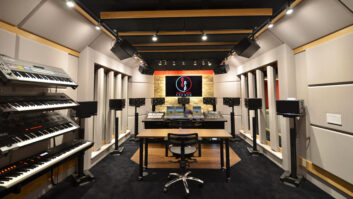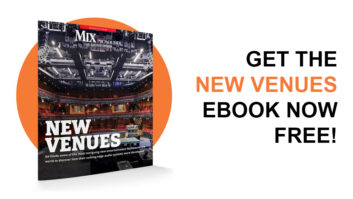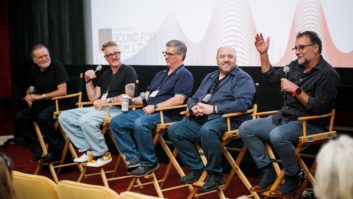
LIVE ON THE SET
For A Complete Unknown, the decision was made early on that all musical performances—those with Timothée Chalamet (who plays Dylan) and his acoustic guitar, and those with a full band—would be recorded live, particularly the former. “He always has his guitar with him,” Maitland says.
While an acoustic performance in a film would normally involve placing a wireless lavalier on the actor’s chest, Maitland says that wasn’t possible because, “Timmy held his guitar in a similar position to the way Bob did, with the body of the guitar up high, which would cover a mic on his chest.” Instead, he opted for placing a DPA 6000 Series subminiature lavalier in the actor’s hair, more typically done with Broadway actors.
For instances where Chalamet is playing in a setup without a stage mic (either a small club or in his apartment), Maitland miked the guitar from the inside. “We took a Sanken COS-11D lavalier mic and cut the cord, so it was just the plug and mic, and attached it to a Shure ADX1M micro-bodypack transmitter with Joe’s sticky tape, inside the belly of the guitar.”

For the band, shown inside the studio set, the actors/musicians all played live on set, tracked by Maitland using the working vintage studio mics seen in the frame. The equipment was set up by Terence McCormack, Maitland’s tech (and nephew), and his longtime boom operator, Jerry Yuen.
There were also prerecords for all band scenes, tracked a year prior to filming (which was delayed by a year due to industry strikes) by executive music producer Nick Baxter, who also provided on-set music direction. The tracks were recorded with session musicians at The Village Recorder and Sunset Sound in Los Angeles, with vocals recorded at Igloo Music Studio.
Chalamet was tracked live, though, on set, and not included in prerecords, except for instances where the playing required was beyond the actor’s reach. “The only thing that would be tweaked in post by Nick where instances where there was some intricate guitar or harmonica that Bob was well known for and only a professional musician would be able to play,” Maitland notes.
The movie band later played to a low-level playback of those pre-records over a loudspeaker on the set, their instruments recorded live by Maitland. Those instruments included electric guitars, bass, organ, piano, and Chalamet’s guitar and vocals. “We muted drums,” Maitland interjects. “Drums are always the killer because they get into everything, and you can’t get them out. But [Tim] never used an in-ear monitor. Even with the live shows, or just on his own, he continually knocked it out of the park, staying within 1 beat per minute of himself, from take to take. It was just incredible.”
RECORDING/WIRELESS SETUP
Maitland’s recording setup starts with a cart he put together in 2020 for the production of West Side Story. The rig includes a 48-channel Allen & Heath SQ-5 digital mixer, making use of 32 channels of wireless, courtesy of 26 Shure ADX1M transmitters, for use by the actors, and eight of the larger ADX1s for booms and stash mics (additional Sennheiser 416s placed on various sets to take advantage of ambient sounds). “It was a good time, five years ago, because wireless was really changing,” Maitland recalls. “All the major companies came in and showed us their new stuff, and Shure was definitely the winner.”
The Shures were valuable not only for recording, but for output use as well, in combination with the SQ-5’s ability to allow Maitland to make multiple sets of mixes, such as for stagebound monitor mixes at the Newport Festival shows.

There was another valuable use of the IEM transmitters: to drive the VU meters seen on the recording console in the Studio A control room set. While all live mics were fed directly to Maitland for recording, he also sent them to on-set Pro Tools operator Derek Pacuk. Pacuk then created individual mixes, which Maitland sent back out to the ADX1Ms, to the prop mixing console’s meters, allowing them to move differently, representing each of the instruments being seen through the control room window.
While Maitland had more than 20 inputs during the Columbia Studios scenes, that number more than doubled for the Newport Festival scenes, which feature various acts, an emcee, Dylan and Joan Baez, and Dylan with his band, as well as audience mics. Maitland faced a number of challenges, because Chalamet’s performance was fed live to the audience/extras (the group of which were extended via visual effects), as well as provided back to the actor via monitors—old school wedges built by the art department, but with modern speakers within.

“It was tough to do, because I needed to hear how much the monitor mix affected Timmy’s microphones,” Maitland explains. “It was important to keep the right balance, so that everything would be usable and cutable in post. So it was a matter of keeping those microphones as clean as possible, while, at the same time, giving the actors what they needed to keep their performance as vibrant as possible.”

The final mix, by Oscar-winning rerecording mixer Paul Massey, was a combination of both Nick Baxter’s prerecords and live recording made by Maitland, with individual actors Chalamet and others still providing their own live performances to camera.
The music performances in A Complete Unknown weren’t the only interesting challenges for Maitland. “When Bob walks down any of the streets on the Greenwich Village outdoor set, all of those little bits and pieces were done live,” he notes. As Chalamet or other actors walk along, one person, say, can be heard singing “Puff the Magic Dragon” from an apartment, an opera singer is belting out a vocal, and another background actor is playing small drums. “As they walk down the street, they’d be passing these little clubs, so we’d put a speaker down the stairs of each one, with different music playing out of it. It was an immersive experience.”
Maitland credits director Mangold for his commitment to that factualness: “He wanted everything happening all the time. Normally, a production sound mixer tries to get the cleanest tracks they possibly can—just dialogue, without any music over it. On this film, everything was going, all the time.”
He notes, “There was always sound going on, whether it was coming in or going out—and often done in a way that I’ve never done before. A Complete Unknown was probably the one of the most difficult, complicated and rewarding films that I’ve ever done. This is a movie about sound. It’s about music. The music is live, it’s raw, it’s not flash—and it’s totally real.”
